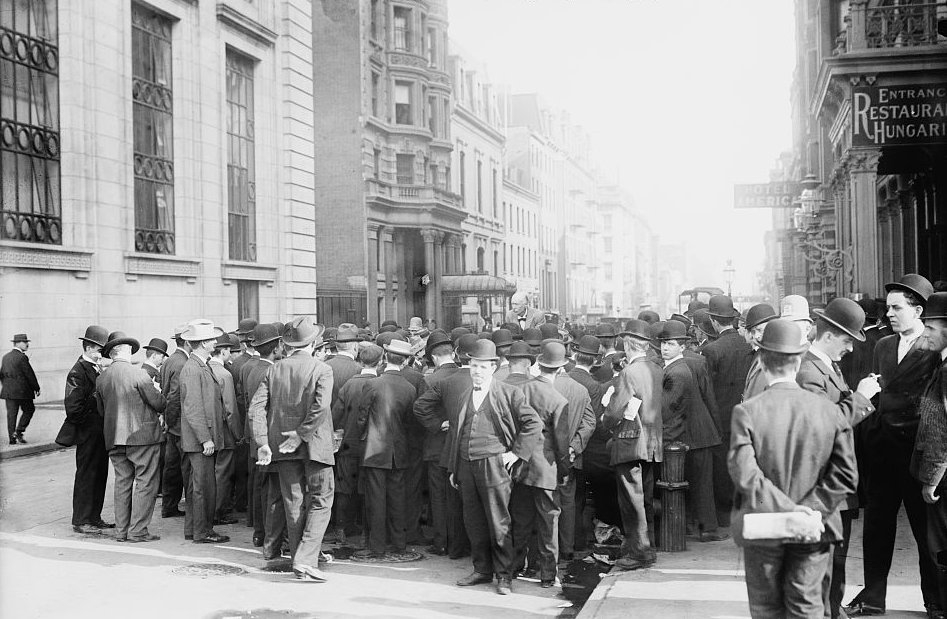American Jewish Socialism arose in the 1880s with mass Jewish immigration from Eastern Europe, but it was not simply a Russian import. Jewish American immigrants turned to Socialism in response to their experiences on both sides of the Atlantic.
Many Jews in late 19th-century Eastern Europe had endured downward socio-economic mobility as traditional Jewish economic niches were undermined by the expanding industrial capitalist system. This experience, combined with persecution under the Tsars and encounters with poverty and factory labor in America, inspired many Jews to look for radical social change.
Jews as Proletarians
The influx of Jewish immigrants from Russia in the 1880s brought with it a small but vocal number of intellectuals, many of whom had had a Russian-language education and some of whom had been active in the early Russian revolutionary movement. In America, they took manual jobs, especially in the fledgling garment industry, and began to see themselves for the first time as proletarians, members of the industrial working class.
Meanwhile, they aligned themselves with either Anarchist or Marxian Socialist ideologies: Anarchists favored direct action and stressed the inherently oppressive class nature of the state, while Socialists (Social Democrats, as they were called) sought to capture control of the state for the working class. In the early years, though, the line between the factions was blurry, and both sides worked together in a number of short-lived organizations and institutions, including the Propaganda Association and the Russian Labor Lyceum.

Help us keep Jewish knowledge accessible to millions of people around the world.
Your donation to My Jewish Learning fuels endless journeys of Jewish discovery. With your help, My Jewish Learning can continue to provide nonstop opportunities for learning, connection and growth.
At first, the Socialist intellectuals found it difficult to influence the much larger community of Jewish immigrant workers, who spoke only Yiddish and had not had the same experiences of the revolutionary movement in Russia. These intellectuals preferred to carry out their activities in Russian, and doubted that serious political ideas could be expressed in Yiddish, which they viewed as an inferior dialect of German. Gradually, however, the radicals began to give speeches and issue publications in Yiddish.
Socialism in Yiddish
Abraham Cahan, a young immigrant from Vilna, Lithuania, is credited with giving the first Yiddish Socialist speech in America. In 1882, after attending a Socialist meeting ostensibly aimed at Jewish workers but at which all of the speakers had given their remarks in Russian or German, Cahan asked the organizers why they did not use the language of the people they were trying to reach. The radicals laughed at the thought and contemptuously suggested that he try it himself.
A week later, in a packed meeting room, Cahan explained the Marxist theory of surplus value in Yiddish. Bernard Weinstein, who was to become secretary of the United Hebrew Trades, a federation of predominantly Jewish trade unions, later wrote in his memoirs that this was the first time he really understood the doctrine of Socialism.
Over time, the radicals’ speeches and publications began to attract more people to their cause. At the same time, the Anarchists lost ground, and most of the Jewish radicals gravitated toward Socialism. In the 1880s and 1890s this meant joining the Socialist Labor Party (SLP).
Nevertheless, the Anarchists remained a visible and vocal presence, with energetic and eloquent champions such as the non-Jewish German Johan Most and Emma Goldman, who had come to the United States from Russia as a teenager. The Anarchists also published a highly regarded Yiddish-language paper, the Fraye arbeter shtime (Free Voice of Labor), known not only for its politics but for its high literary standards.
By the early 1900s, the institutional groundwork for a powerful Jewish Socialist movement had been laid. One of the most important institutions of the movement was the Workmen’s Circle (Arbeter Ring), which began as a mutual aid society in 1892 and was reorganized as a multi-branch fraternal order in 1900.
The Workmen’s Circle provided its members with material assistance, such as health and death benefits, and its branches served as venues for social interaction and cultural expression. Branches also supported their members who were on strike, and the order as a whole aided striking unions and Socialist causes. Members were permitted to hold whatever political or religious opinions they liked, as long as they did not vote for the candidates of a bourgeois party. The order itself was resolutely secular.
The Forward
Another central institution of Jewish Socialism was the Jewish Daily Forward (Forverts), a newspaper founded in 1897 by dissident members of the SLP who became dissatisfied with the increasingly authoritarian and sectarian leadership of the party’s leader Daniel De Leon (himself of Jewish origin, but with no ties to the Jewish community). Abraham Cahan served as the newspaper’s first editor, but he soon left to pursue a career in English-language journalism.
When Cahan returned to the Forward in 1902, he brought with him a flair for the sensational and a talent for sensing the pulse of the Yiddish-reading public. He turned the Forward into a peculiar mix of earnest Socialist propaganda and sensationalist yellow journalism, all presented in a lively, popular style and a simple Yiddish.
The formula worked, and the Forward soon gained more readers than any other Yiddish daily in the world or Socialist daily in the country. Not only was it the primary voice of Jewish immigrant Socialism, but it was also a highly successful business enterprise, giving away much of its profit, as part of its mission, to labor and Socialist causes, Jewish and non-Jewish.
Organizing Unions and Community
Jewish Socialists also controlled many of the predominantly Jewish trade unions, especially in the garment industry. Chief among these was the International Ladies’ Garment Workers’ Union, founded in 1900, which organized workers in the women’s clothing trade, most of whom were Jewish. The union struggled for years to maintain its existence, until a series of massive strikes in 1909 and 1910 established it as a force to be reckoned with not only in the industry, but also in communal politics.
The Amalgamated Clothing Workers of America, whose members made men’s clothing, was founded in 1914, and many of the union’s officers, staffers, and members were Socialists. Likewise, the United Hebrew Trades was led by Socialists.
Jewish Socialist attitudes toward Jewish identity and culture varied. Most of the 19th-century pioneers of the movement were ardent cosmopolitans. Even as they adopted Yiddish as a medium to reach the Jewish workers, they rejected any special appeal to Jewish interests or identity. The Anarchists became especially infamous for organizing balls, at which revelers danced, ate, drank, sang revolutionary songs, and performed skits, all in a gesture of contempt for Jewish religious practice.
The first decade of the 20th century saw an influx of immigrants who had been active in the Jewish Labor Bund in Russia. The Bundists fought for the rights of workers as well as for Jewish national rights . In Russia, for example, they demanded national-cultural autonomy for the Jews, with Jewish control over Yiddish-language schools and other public institutions. They also saw Yiddish not just as a medium of communication, but also as the carrier of secular Jewish national identity. The Workmen’s Circle gradually fell under control of the Bundists, and began to promote Yiddish secular culture. Bundists also dominated the Jewish Socialist Federation, the Yiddish-language arm of the Socialist Party (SP), which had overtaken the SLP as the most important Socialist party in the United States.
Labor Zionists sought to combine the principles of Socialism and Jewish nationalism. Friendly toward both Yiddish and Hebrew, they formed parallel institutions, including a fraternal order, the Jewish National Workers’ Alliance. Whatever their orientation, Jewish Socialist leaders and organizations were adamantly secular, though rank-and-file supporters may not have been as consistently irreligious.
Entering Politics
In the 1910s, the Socialist Party entered a brief electoral heyday, dominating politics in the Jewish districts of New York City. In 1914, the Lower East Side sent Socialist labor lawyer Meyer London to Congress with a pledge to represent both working class and immigrant Jewish interests.
In the following years, Jewish districts in New York elected numerous Socialist members to the state assembly and the city board of aldermen, and even a municipal judge. In 1917, Morris Hillquit, another immigrant lawyer, garnered more than 20 percent of the vote in a four-man race for mayor of New York. Hillquit would later serve as national chairman of the Socialist Party.
This electoral peak came to an end in the early 1920s, brought down by gerrymandering, Democratic-Republican coalitions in Socialist districts, government repression, and the bitter split with the Communists after the Russian Revolution. But Socialists continued to exert influence through their control of important communal institutions, such as the Forward, the Workmen’s Circle, and the unions. Eventually, they joined the New Deal coalition under Franklin Roosevelt, bringing their brand of Social Democratic politics into the mainstream. The liberalism that American Jews exhibit to this day descends partly from this Socialist legacy.


